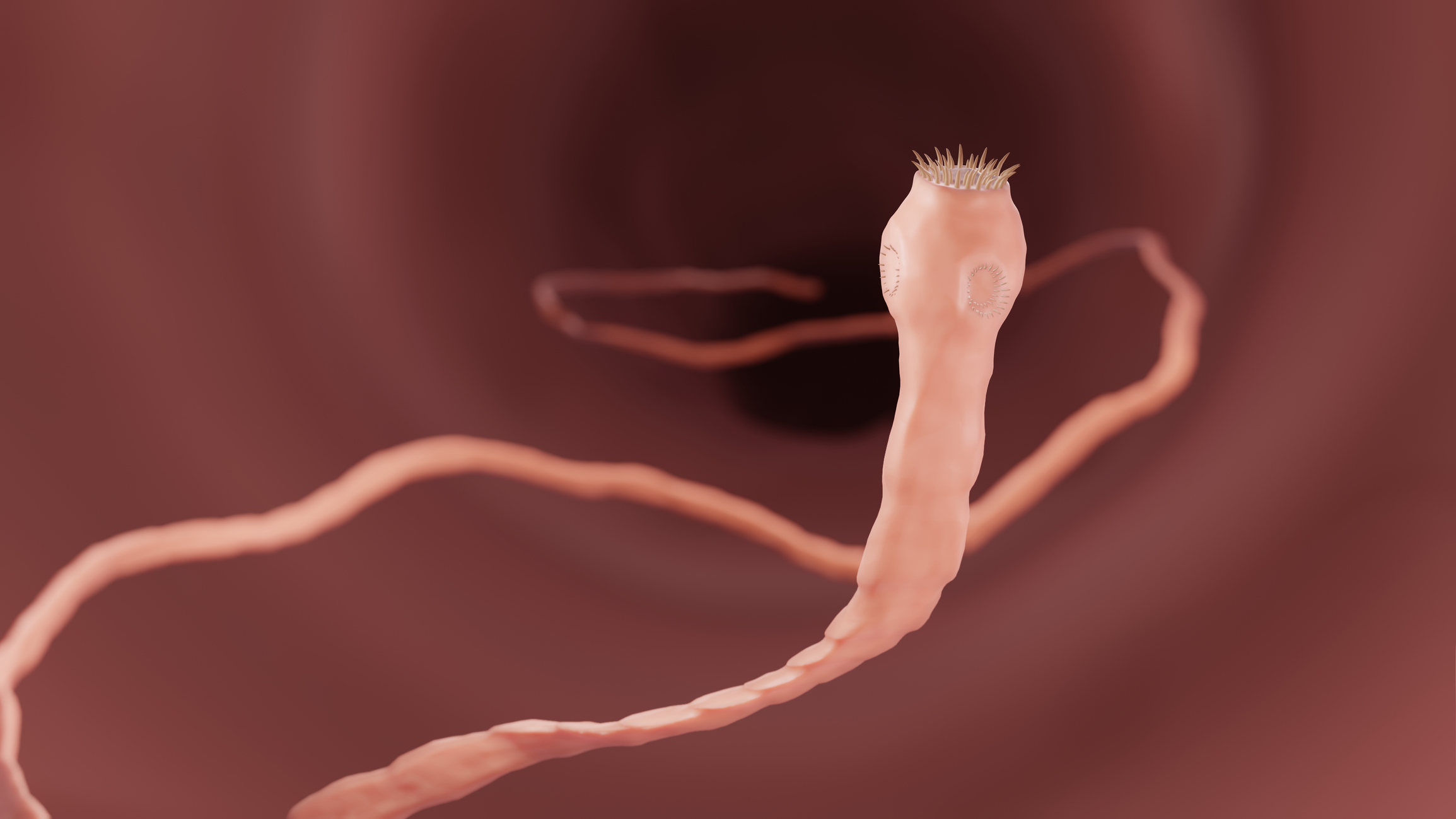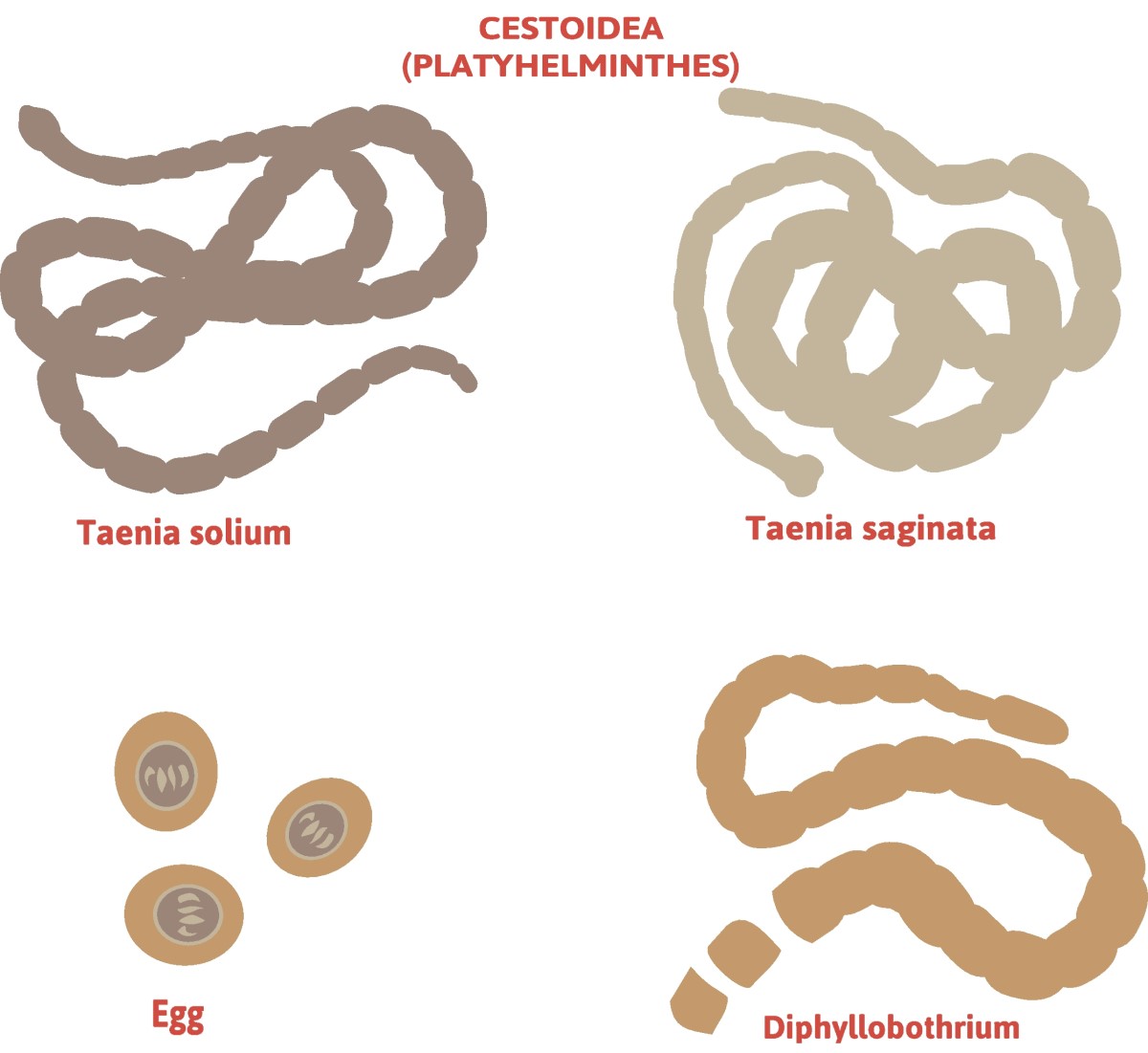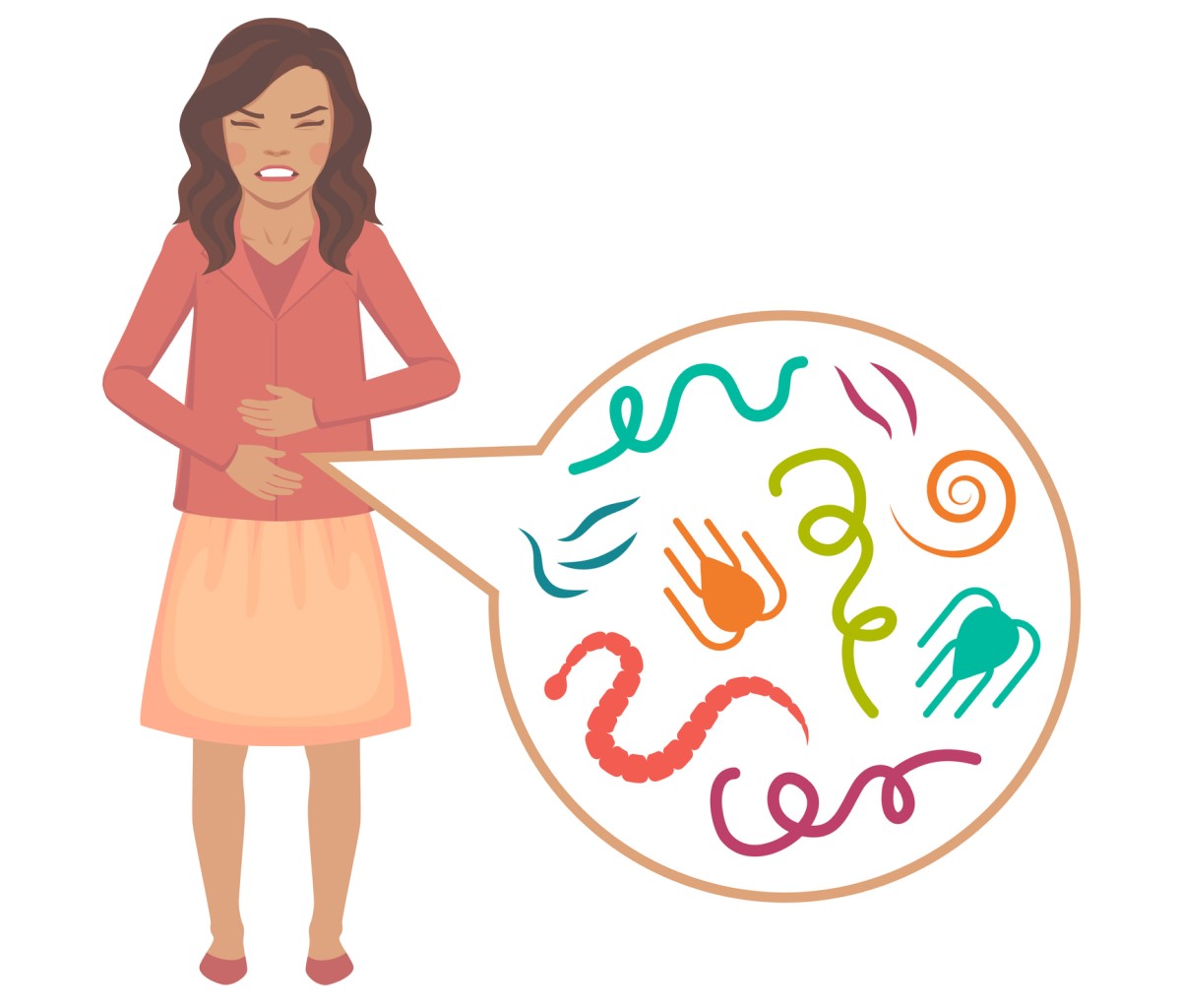- researchgate.net - Molecular identification of Taenia hydatigena from domestic and wild animals in Slovakia, Central Europe
- researchgate.net - INTESTINAL PARASITES IN DOMESTIC WILDLIFE BREEDING IN SLOVAKIA - A POSSIBLE SOURCE OF INFECTION FOR HUMANS?
- sciencedirect.com - taenia saginata
- parasitesandvectors.biomedcentral.com - Epidemiology of Taenia saginata taeniasis/cysticercosis: a systematic review of its distribution in Central and Western Asia and the Caucasus.
Teniasis - tapeworm: How is it transmitted and what are the symptoms?

Teniasis is a parasitic intestinal disease caused by tapeworms. Worldwide, it is one of the most widespread parasitic diseases.
Most common symptoms
- Malaise
- Abdominal Pain
- Headache
- Spirituality
- Increased body temperature
- Cramps in the abdomen
- Nausea
- Head spinning
- Diarrhoea
- Fever
- Rash
- Indigestion
- Buds
- Dry cough
- Muscle cramps
- Itching of the rectum
- Itchy skin
- Fatigue
- Reddened skin
- Constipation
- Blurred vision
- Vomiting
- Increased appetite
Characteristics
In the case of taeniasis caused by the defenceless tapeworm, a person becomes infected by eating undercooked beef.
In the case of the long-legged tapeworm, a person becomes infected by eating undercooked pork.
Tapeworm is one of the most widespread parasitic diseases in the world. There are an estimated 50 million cases of this disease worldwide. The most common occurrences are in the following regions:
- South and Central America
- Africa
- South and Central Asia
Interesting...
In the past, tapeworms were a very popular delicacy. In France, for example, women ate tapeworms to lose weight in corsets.

Causes
Foods at risk include:
- steak tartare
- bloody steaks
- raw meatloaf
- kebabs
- sausages
You are often interested in:
How long can a tapeworm be?
More by type...

1. Defenceless tapeworm (Taenia saginata)
The adult defenceless tapeworm can be 5 to 10 metres long. Occasionally it can be up to 12 metres long.
There are 4 suckers (acetabula) on the head (scolex) which serve to attach to the intestinal lining of the host. The body of the tapeworm (strobila) consists of 1 000 to 2 000 cells. The mature cells contain 80 to 100 000 eggs.
Defenseless tapeworm eggs can survive in the external environment for up to 200 days.
Because the defenceless tapeworm has no digestive system, it takes up nutrients from the host through the entire surface of its body. The definitive host is man. It can live up to 25 years in the human gut. The intermediate host is cattle.
Humans (the definitive host) become infected by eating the larval stages of tapeworms (cysticerci) in raw or undercooked beef. In most cases, the source of infection is steak tartare.
Cattle (intermediate host) can become infected by ingestion of tapeworm eggs through various routes (in the stall, on feed, in water).
Did you know that...?
Several mature cells emerge from the body of the definitive host (human) every day. Each of these contains about 100,000 eggs. The cells of the defenceless tapeworm have the ability to self-propel. This is also the basic difference between this species and the long-legged tapeworm. People are usually surprised by this.
In humans (definitive host) it causes a disease called teniasis. In cattle (intermediate host) it causes cysticercosis. It is also known as the bovine tapeworm, depending on the intermediate host.

The incidence of the defenceless tapeworm is worldwide. It is most commonly found in the following areas:
- Africa
- Eastern Europe
- Latin America
- Philippines
2. Long-legged tapeworm (Taenia solium)
The longhorn tapeworm is considered the most damaging tapeworm. It develops in the small intestine. It reaches a length of 2-3 m at maturity. In some cases it can be up to 8 m long.
The long-legged tapeworm has a flat body consisting of a large number of cells. The head is followed by a neck from which the cells grow. The mature cells contain up to 50 000 oval eggs.
Approximately 6 long-legged tapeworm cells are excreted daily in the faeces. Unlike the defenceless tapeworm, the long-legged tapeworm cells are not capable of active movement.
The long-legged tapeworm is considered the most dangerous food-borne parasite.
Adults live in the small intestine, where they grow to a length of 2-3 m. In some cases they can be up to 8 m long.
The body of this tapeworm is composed of a large number of cells (proglotids). The last, mature proglotids may contain up to 50 000 eggs. An infected person excretes approximately 6 of these cells per day in the faeces. Unlike previous species, the cells of the long-legged tapeworm are not capable of active movement.
Interesting fact:
A person can be both an intermediate host and a definitive host. It is more dangerous to a person's health to be an intermediate host.
Even if a person is in the position of a definitive host, he or she can also be an intermediate host. This is a much more serious condition medically than the intestinal form of the disease.
The developmental cycle of the long-legged tapeworm
In the intestinal form of the disease, a person becomes infected by eating cysticerci in raw or undercooked pork.
The cysticerci hatch into a head in the small intestine, which attaches to the intestinal wall. It takes approximately 3 months for the adult tapeworm to develop. The intermediate host is most often a pig, but humans can also become infected. Infection occurs after accidental consumption of the eggs (e.g. in contaminated food or water).
In the stomach of the intermediate host, the larva (oncosphere) is released from the egg. It enters the bloodstream and migrates to various organs and tissues.
The most commonly infested are:
- striated muscles
- the brain
- eye
- liver
- lungs
The most serious and also the most common is the localization of cysts in the brain. In this case we speak of neurocysticercosis.
3. Hymenolepidosis - Children's tapeworm (Hymenolepis nana)
The baby tapeworm (Hymenolepis nana) is the smallest human tapeworm. It is 1 to 4 cm long and 1 mm thick. It has a flat, light-coloured body that can be made up of up to 200 cells.
The child tapeworm does not need an intermediate host for its development. Its development can therefore be direct or indirect. The definitive host can be humans, primates or rodents, which become infected by accidentally ingesting the eggs, for example on contaminated fruit.
In the case of indirect development, intermediate hosts may be flea larvae (Pulex), Tenebrio molitor larvae (so-called 'mealworms') and other insects. The definitive host is infected by ingestion of infected insects.
The ingested eggs enter the gastrointestinal tract. In the small intestine, they release a larval oncosphere, which burrows into the intestinal villi. They develop a cysticercoid, which gradually grows into an adult tapeworm. The adult tapeworm produces eggs, which are excreted externally in the faeces.
It is named after the frequent infestation of children with tapeworms...
The name childhood tapeworm was coined because it is most often contracted by children who have not yet developed sufficient hygiene habits. The disease that the tapeworm causes is called hymenolepsy.
Symptoms of the disease are mild digestive problems such as abdominal pain, diarrhoea or vomiting.
4. Dipylidiosis - Dog tapeworm (Dipylidium caninum)
The dog tapeworm is one of the smaller species of tapeworms. It can reach a length of 20 to 50 cm. The disease caused by the dog tapeworm is called dipylidiosis.
The definitive host may be a dog, cat, fox or wolf.
Occasionally, the host may also be a human. Humans become infected by accidentally ingesting infected fleas in contaminated food or through the saliva of domestic animals.
The intermediate host is the flea (dog, cat).
What is the developmental cycle of the canine tapeworm?
The definitive host excretes a cocoon of eggs into the external environment via the feces.
The flea ingests the eggs. It then develops into a cysticercoid larva.
The definitive host swallows the infected flea. For example, a dog swallows a flea while biting an itchy spot where the flea drinks blood. The adult tapeworms then develop in the definitive host's small intestine.
Symptoms
The tissue form (cysticercosis) in animals is asymptomatic.
For example, in the case of localization of cysts in the brain, seizures and convulsions, neurological symptoms appear. In the case of localization in the eye, visual disturbances occur, blindness may occur.
The intestinal form, where the person is the definitive host, can manifest itself in digestive disorders:
- nausea
- flatulence
- diarrhoea
Read also:
Ascariasis, hookworm, roundworm: What are its causes and symptoms?
Parasites, pets and health? Distribution, symptoms and treatment
Parasites, lice or other diseases in our schools and nurseries?
The following table lists the symptoms that occur with each type of tapeworm
| Tapeworms | Symptoms |
| Defenceless tapeworm |
|
| Tapeworm longhorn |
|
| Children's tapeworm |
|
| Canine tapeworm |
|

Diagnostics
- Direct diagnosis.
Direct diagnostics is performed in specialized parasitological departments:
- stool (as evidence of the presence of tapeworms in the stool).
- Urine
- blood
- cerebrospinal fluid
- sputum
- biopsy material (muscle, intestine, liver, bladder, skin)

Indirect diagnostics
Indirect diagnosis is based on serological detection of antibodies in the blood and allergic skin reactions (intradermal tests).
- Auxiliary examination methods
Ancillary methods of investigation include blood tests. Imaging methods include ultrasonography, computed tomography, scintigraphy and laparoscopy.
Course
The adult tapeworm releases its egg cells. These are released into the external environment when the stool is passed (tapeworm cells in the stool).
In some cases, auto-infection with the tapeworm's own eggs is possible. The eggs develop into larvae in the stomach. These penetrate the lining of the intestine and enter various tissues and organs:
- subcutaneous tissue
- skeletal muscles
- brain
- eyes
How it is treated: Teniasis
Treatment of teniasis - tapeworms: both drugs and surgery
Show moreHow to find out if you have a tapeworm in your body
Teniasis is treated by
Other names
Interesting resources










